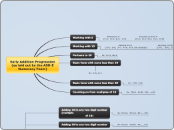作者:Amy Boljkovac 12 年以前
674
Addition Progression
This mapping shows a progression of how to teach addition from the very beginning to 100.

Followed By:
Sums of Numbers Less
Than 100
Adding any 2-digit number with any other
2-digit number with sums less than 100.
Ex: 34+58, 67+ 25
Adding a 2-digit teen number with any other
2-digit number
Ex: 36+15, 49+14
Adding a 2-digit and a 1-digit number
Ex: 74+9, 73+8, 54+7
Adding 2-digit numbers with sums below 100(not crossing over into the next decade)
Ex: 34+12, 48+11, 56+13
Partners to 100
Multiples of 10
(10+90, 70+30, etc)
2-digit numbers
(11+89, 65+35, etc)
Adding a multiplie of 10 to a 2-digit number
with a sum less than 100
Ex: 53+30, 24+70, 40+39
Adding multiples of 10 with sums less than
100
Ex: 50+30, 20+40
Adding 10 to any two digit number
Ex: 43+10, 10+57, 34+__=44
Adding 10 to any two digit number (multiple
of 10)
Ex: 40+10, 30+10, 50+__=60.
Early Addition Progression
(as laid out by the ASD-E Numeracy Team)
Counting on from multiples of 10
Ex: 20+6, 4+30, 20+__=24
Basic facts with sums less than 20
Ex: 7+8, 6+6
Basic facts with sums less than 10
Ex: 3+5, 4+3
Partners to 20
Ex: 17+3, 18+2
Working with 10
Partners to 10
(1+9, 2+8, 3+7, 4+6, 5+5, and reversals)
Counting on from 10
(10+1, 10+2, 10+3, etc.)
Working with 5
Partners to 5
(4+1, 3+2, 2+3, 1+4)
Counting on from 5
(5+1, 5+2, 5+3, 5+4, 5+5)

